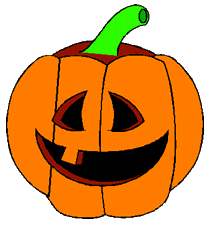|
A pumpkin is a berry in the cucurbitaceae
family, which
also includes cucumbers, melons, gourds, and squash.
All of these plants are native to the Americas.
|
 |
|
Jack o’ lanterns originated in Ireland
where people placed candles in
hollowed-out turnips to keep away
spirits and ghosts. From 1845 to
1850, more than 700,000 Irish
immigrated to the United States,
where pumpkins were available.
|
 |

Halloween History
Holidays and festivals have
been celebrated at the
end of October for thousands of years. The word
"Halloween" has its origins in the Catholic Church. It
comes from a contraction of All Hallows Eve.
November 1, "All Saints Day", is a Catholic day of
observance in honor of saints. But, in the 5th century BC, in
Celtic Ireland, summer officially ended on October 31. The
holiday was called Samhain (sow-en),
or the Celtic New year.
One version says that, on that day, the disembodied
spirits of all those who had died throughout the
preceding year would come back searching for living
bodies to possess for the next year. It was believed to
be their only hope for the afterlife. The Celts believed
all laws of space and time were suspended during this
time, allowing the spirit world to mingle with the living.
Naturally, the living did not want to be possessed.
So on the night of October 31, villagers would put
out the fires in their homes, to make them cold and
undesirable. They would then dress up in ghoulish
costumes and noisily parade around the neighborhood,
being as destructive as possible in order to frighten
away spirits looking for bodies to possess.
The custom of Halloween was brought to America
in the 1800's by European immigrants.
|